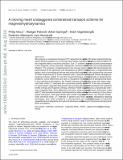| dc.contributor.author | Mocz, Philip | |
| dc.contributor.author | Pakmor, Rüdiger | |
| dc.contributor.author | Springel, Volker | |
| dc.contributor.author | Vogelsberger, Mark | |
| dc.contributor.author | Marinacci, Federico | |
| dc.contributor.author | Hernquist, Lars | |
| dc.date.accessioned | 2017-05-02T16:54:54Z | |
| dc.date.available | 2017-05-02T16:54:54Z | |
| dc.date.issued | 2016-08 | |
| dc.date.submitted | 2016-07 | |
| dc.identifier.issn | 0035-8711 | |
| dc.identifier.issn | 1365-2966 | |
| dc.identifier.uri | http://hdl.handle.net/1721.1/108588 | |
| dc.description.abstract | We present a constrained transport (CT) algorithm for solving the 3D ideal magnetohydrodynamic (MHD) equations on a moving mesh, which maintains the divergence-free condition on the magnetic field to machine-precision. Our CT scheme uses an unstructured representation of the magnetic vector potential, making the numerical method simple and computationally efficient. The scheme is implemented in the moving mesh code arepo. We demonstrate the performance of the approach with simulations of driven MHD turbulence, a magnetized disc galaxy, and a cosmological volume with primordial magnetic field. We compare the outcomes of these experiments to those obtained with a previously implemented Powell divergence-cleaning scheme. While CT and the Powell technique yield similar results in idealized test problems, some differences are seen in situations more representative of astrophysical flows. In the turbulence simulations, the Powell cleaning scheme artificially grows the mean magnetic field, while CT maintains this conserved quantity of ideal MHD. In the disc simulation, CT gives slower magnetic field growth rate and saturates to equipartition between the turbulent kinetic energy and magnetic energy, whereas Powell cleaning produces a dynamically dominant magnetic field. Such difference has been observed in adaptive-mesh refinement codes with CT and smoothed-particle hydrodynamics codes with divergence-cleaning. In the cosmological simulation, both approaches give similar magnetic amplification, but Powell exhibits more cell-level noise. CT methods in general are more accurate than divergence-cleaning techniques, and, when coupled to a moving mesh can exploit the advantages of automatic spatial/temporal adaptivity and reduced advection errors, allowing for improved astrophysical MHD simulations. | en_US |
| dc.language.iso | en_US | |
| dc.publisher | Oxford University Press | en_US |
| dc.relation.isversionof | http://dx.doi.org/10.1093/mnras/stw2004 | en_US |
| dc.rights | Creative Commons Attribution-Noncommercial-Share Alike | en_US |
| dc.rights.uri | http://creativecommons.org/licenses/by-nc-sa/4.0/ | en_US |
| dc.source | arXiv | en_US |
| dc.title | A moving mesh unstaggered constrained transport scheme for magnetohydrodynamics | en_US |
| dc.type | Article | en_US |
| dc.identifier.citation | Mocz, Philip; Pakmor, Rüdiger; Springel, Volker; Vogelsberger, Mark; Marinacci, Federico and Hernquist, Lars “A Moving Mesh Unstaggered Constrained Transport Scheme for Magnetohydrodynamics.” Monthly Notices of the Royal Astronomical Society 463, no. 1 (August 10, 2016): 477–488. | en_US |
| dc.contributor.department | Massachusetts Institute of Technology. Department of Physics | en_US |
| dc.contributor.department | MIT Kavli Institute for Astrophysics and Space Research | en_US |
| dc.contributor.mitauthor | Vogelsberger, Mark | |
| dc.contributor.mitauthor | Marinacci, Federico | |
| dc.relation.journal | Monthly Notices of the Royal Astronomical Society | en_US |
| dc.eprint.version | Author's final manuscript | en_US |
| dc.type.uri | http://purl.org/eprint/type/JournalArticle | en_US |
| eprint.status | http://purl.org/eprint/status/PeerReviewed | en_US |
| dspace.orderedauthors | Mocz, Philip; Pakmor, Rüdiger; Springel, Volker; Vogelsberger, Mark; Marinacci, Federico; Hernquist, Lars | en_US |
| dspace.embargo.terms | N | en_US |
| dc.identifier.orcid | https://orcid.org/0000-0001-8593-7692 | |
| dc.identifier.orcid | https://orcid.org/0000-0003-3816-7028 | |
| mit.license | OPEN_ACCESS_POLICY | en_US |

